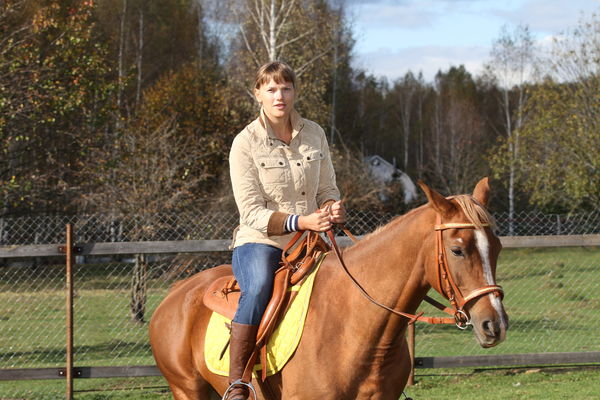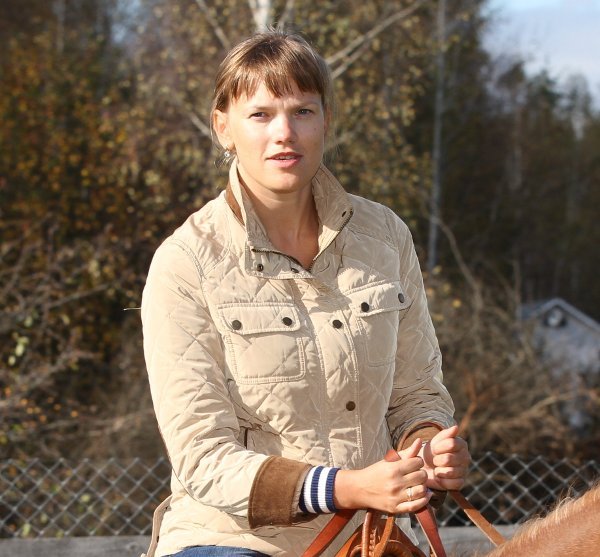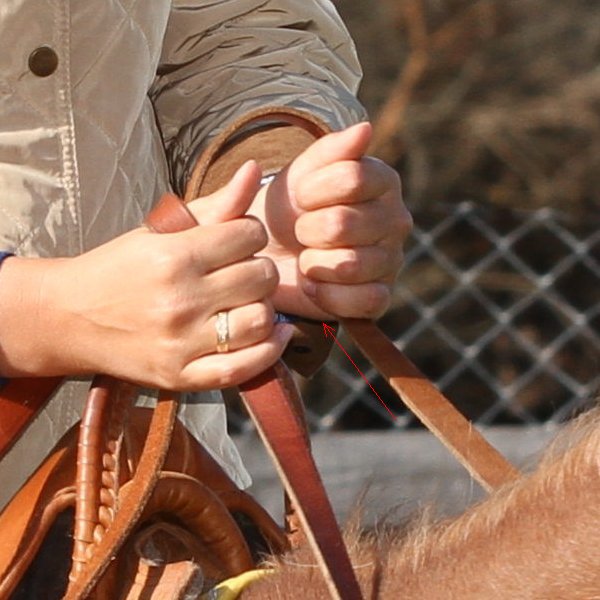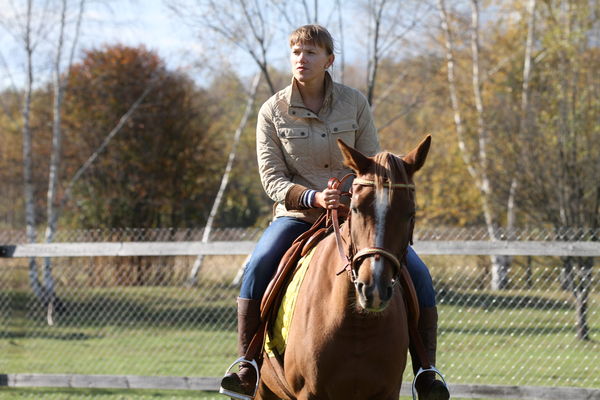Ambient and flash exposure compensations -- what about highlights?
Oct 2, 2012 13:26:41 #
Shot with a Canon 7D.
f/7.1, 1/250, ISO 100
I was shooting in Tv mode, as I normally do when using fill flash outside.
I set the camera to max flash sync speed (1/250), set the base ISO, and let it do it's own metering via aperture.
I put 1/4 CTO gel on the flash to warm it up and make it closer to the temp of the sun's light.
For this shot, I dialed in flash exposure compensation of -2/3 stops. Ambient exposure compensation was set to 0.
Part of her face (and the coat) has blown highlights. I can't stop wondering if part of the reason the highlights were blown was because of the fill flash.
After all, the flash adds some light. So if the highlights were already close to being blown without the flash, then flash just added the final kick. So the attempt to bring out the shadows by using fill flash resulted in blown highlights.
This got me thinking. Would it be better to dial down ambient exposure compensation when using fill flash with the subject's face partially lit by direct sunlight?
Would it help?
If yes, then what would be the appropriate EC?
My gut tells me to try something along the lines of EC -1/3 with FEC -2/3.
Or would it just make the whole image seem underexposed?
Can anyone share any metering math, reasoning, or logic behind this?
f/7.1, 1/250, ISO 100
I was shooting in Tv mode, as I normally do when using fill flash outside.
I set the camera to max flash sync speed (1/250), set the base ISO, and let it do it's own metering via aperture.
I put 1/4 CTO gel on the flash to warm it up and make it closer to the temp of the sun's light.
For this shot, I dialed in flash exposure compensation of -2/3 stops. Ambient exposure compensation was set to 0.
Part of her face (and the coat) has blown highlights. I can't stop wondering if part of the reason the highlights were blown was because of the fill flash.
After all, the flash adds some light. So if the highlights were already close to being blown without the flash, then flash just added the final kick. So the attempt to bring out the shadows by using fill flash resulted in blown highlights.
This got me thinking. Would it be better to dial down ambient exposure compensation when using fill flash with the subject's face partially lit by direct sunlight?
Would it help?
If yes, then what would be the appropriate EC?
My gut tells me to try something along the lines of EC -1/3 with FEC -2/3.
Or would it just make the whole image seem underexposed?
Can anyone share any metering math, reasoning, or logic behind this?
the whole image

blown highlights, you can see fill flash catchlights, 100% crop of the face

closer look overall, the coat is also blown, but i can live with that. not the face though.

this is how much light the flash added. you can judge the difference by the tiny flash's shadow where the sunlight is also blocked

Oct 2, 2012 13:45:43 #
I'll just throw this out for consideration:
For your fill-flash to cause your blown highlights, it would have to actually be brighter than your key-light (the sun). If it were, the other side of the face would be blown, also.
There are plenty of people here smarter than me, so if my idea is wrong, it won't last long!
Terrific post, thank you!
For your fill-flash to cause your blown highlights, it would have to actually be brighter than your key-light (the sun). If it were, the other side of the face would be blown, also.
There are plenty of people here smarter than me, so if my idea is wrong, it won't last long!
Terrific post, thank you!
Oct 2, 2012 13:51:27 #
Quote:
For your fill-flash to cause your blown highlights, it would have to actually be brighter than your key-light
Ah, but that's not true!
Think about it for a minute. This was my "aha moment of the day" today.
If you have one light source with some intensity, and you add more lights that are dimmer. Do you really think all those extra photons from the dimmer lights will somehow disappear and not make it to the sensor?
If you have 5 light bulbs lighting a room. One of those light bulbs happens to be 100W and the other four 60W each, do you think that turning the four bulbs on or off would have no effect?
Photons add up regardless of the light source's intensity.
So if the sunlight for a given aperture/shutter speed/iso reflected off of a given subject produced enough photons to "almost" saturate photosites of a sensor, then adding more photons from flash (even if it's not as bright as the sun) would certainly help fill the photosites and blow the highlights.
Or at least that's my thinking. But I don't see any obvious flaws here.
Oct 2, 2012 14:56:10 #
Dammit, KG! You may have clouded the issue with truth! You have brought out my insecurities and I shall not advance my position, but neither shall I recede!
Your example of the light bulbs in a room is a good one, and has me scratching my head. But this is referring to ambient light, and the first issue (your photograph) is dealing with reflected light. So...I am going to hold fast until others come, either to MY aid, or YOURS.
What a great conversation...I need a nap!
Let me add, before I doze off: Light still falls off with increasing distance, it's the LAW!
Your example of the light bulbs in a room is a good one, and has me scratching my head. But this is referring to ambient light, and the first issue (your photograph) is dealing with reflected light. So...I am going to hold fast until others come, either to MY aid, or YOURS.
What a great conversation...I need a nap!
Let me add, before I doze off: Light still falls off with increasing distance, it's the LAW!
Oct 2, 2012 19:38:37 #
Danilo wrote:
Let me add, before I doze off: Light still falls off with increasing distance, it's the LAW!
Let me add, before I doze off: Light still falls off with increasing distance, it's the LAW!
Then the subject might be better exposed farther away from the sun!
Let's see, the distance from the sun.... 92,960,000 miles... times the crop factor, is that 1.6 or 1.5?.... compute the inverse square law...
:lol:
Oct 2, 2012 20:49:49 #
Goofy, Goofy, Goofy...
I'll pretend you didn't say that. Of course the light from the sun is still falling off at the same rate as it does from Mercury, by the square of the increase in distance. To get KG's subject significantly farther from the sun would be a trick...yes. But the output of his flash is a different matter!
Don't forget...I've had a nap!
I'll pretend you didn't say that. Of course the light from the sun is still falling off at the same rate as it does from Mercury, by the square of the increase in distance. To get KG's subject significantly farther from the sun would be a trick...yes. But the output of his flash is a different matter!
Don't forget...I've had a nap!
Oct 2, 2012 21:50:49 #
I do believe your ambient light exposure is too high. You have a brightly lit subject against a dark background which is causing your light meter to overexpose the highlights. Use some exposure compensation to bring the highlights down. Your flash exposure will not cause the highlights to get over exposed.
Here is the basic concept: Let's assume that the difference between the shadow side of her face and the highlight side is 3 stops of exposure. That means that it is 8 times as bright. Remember, each stop represents a doubling or halving of the amount of light depending whether you are going up or down. If you double the amount of light on the shaded side to get one stop more exposure there, you would need to add 16 times as much light to the sunny side to add one stop of exposure. That means that the amount of light that you are adding to the sunny side is only about 1/4 of a stop. I hope this is clear.
Watch your background! You have a tree growing right out of the top of her head.
Here is the basic concept: Let's assume that the difference between the shadow side of her face and the highlight side is 3 stops of exposure. That means that it is 8 times as bright. Remember, each stop represents a doubling or halving of the amount of light depending whether you are going up or down. If you double the amount of light on the shaded side to get one stop more exposure there, you would need to add 16 times as much light to the sunny side to add one stop of exposure. That means that the amount of light that you are adding to the sunny side is only about 1/4 of a stop. I hope this is clear.
Watch your background! You have a tree growing right out of the top of her head.
Oct 2, 2012 22:54:25 #
So, Danilo, you had it right but didn't quite know how to explain it!
Oct 3, 2012 04:58:29 #
Quote:
I do believe your ambient light exposure is too high.
I think so too. And it makes sense for the camera's metering to be somewhat off on the highlights given the angle of the sun and the background.
But my question right now is whether the fill flash added something to the blown highlights or not. (In this shot and in general.)
I'm attaching another shot with f/5.6, 1/250, ISO 100. The flash did not fire here.
You'll notice that the highlights on her face are blown as well. But they are blown by a similar amount not more. Even though the aperture was wider.
The shot I posted originally is f/7.1 with fill flash. The shot I'm posting below is f/5.6 without flash. The same shutter speeds and ISO.
the whole image

100% crop, f/5.6, no flash

reposting 100% crop, f/7.1 with fill flash

Oct 3, 2012 05:22:46 #
Quote:
Here is the basic concept: Let's assume that the difference between the shadow side of her face and the highlight side is 3 stops of exposure.
Yep. I read that somewhere. The rule of thumb is 3 stops difference between the sunlit part of the face and the shaded part. So we are good here.
Quote:
If you double the amount of light on the shaded side to get one stop more exposure there, you would need to add 16 times as much light to the sunny side to add one stop of exposure. That means that the amount of light that you are adding to the sunny side is only about 1/4 of a stop. I hope this is clear.
That's absolutely true.
But!
What if the highlights (given ambient exposure metering) were almost blown, but not quite blown. Say, 1/5th stop away from totally saturating the respective photosites.
And when you add a stop of light to the shadows, at the same time you add 1/4 stop to the highlights. Now, you would have completely blown highlights. Wouldn't you?
That's what I've been pondering.
Not whether fill flash blows highlights on its own, but if it's possible for the fill flash to be the last straw, so to speak, in certain situations.
And if so, what would be the appropriate EC dial down to compensate for it (maybe in conjunction with FEC).
Oct 3, 2012 06:26:05 #
Danilo wrote:
Goofy, Goofy, Goofy...
I'll pretend you didn't say that. Of course the light from the sun is still falling off at the same rate as it does from Mercury, by the square of the increase in distance. To get KG's subject significantly farther from the sun would be a trick...yes. But the output of his flash is a different matter!
Don't forget...I've had a nap!
I'll pretend you didn't say that. Of course the light from the sun is still falling off at the same rate as it does from Mercury, by the square of the increase in distance. To get KG's subject significantly farther from the sun would be a trick...yes. But the output of his flash is a different matter!
Don't forget...I've had a nap!
The trick is to wait till the planet & sunject rotate 180 degrees on it's axis, then he's the furthest possible, while on this planet that is...oh crap now I need a nap...oh wait, I just woke up...now what?
Oct 3, 2012 06:59:43 #
Oct 3, 2012 07:27:15 #
http://www.sekonic.com/Classroom/Webinars/ArchivedWebinars.aspx
go to this website they have some great videos on ambient and fill flash that are a great help.
go to this website they have some great videos on ambient and fill flash that are a great help.
Oct 3, 2012 08:07:08 #
Definitely overall overexposure. If you were about 1.5 F stops darker, you probably wouldn't have blown the highlights, and shadows would still have definition. Not a hard fix in pp.
Oct 3, 2012 08:27:05 #
Georgia Peddler
Loc: Brunswick, GA
First series - why is tree growing out of her head-Great shots otherwise??
If you want to reply, then register here. Registration is free and your account is created instantly, so you can post right away.






